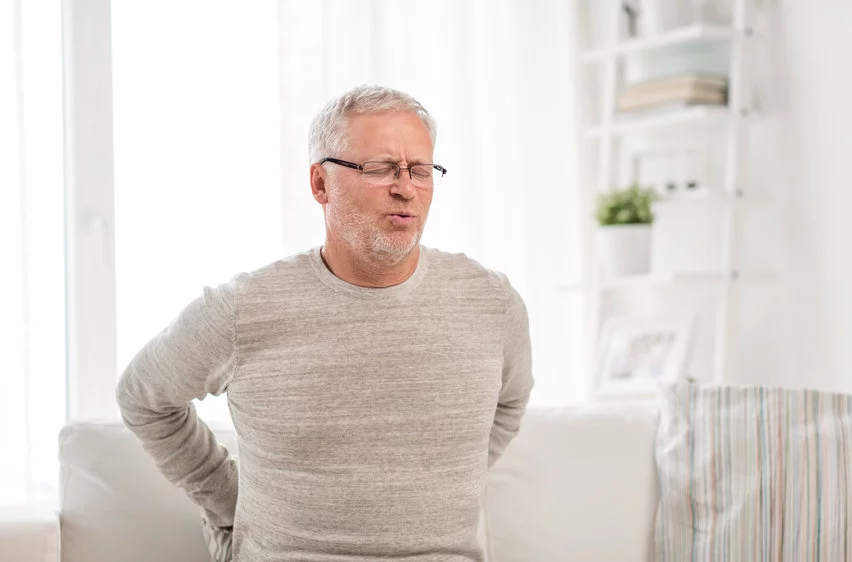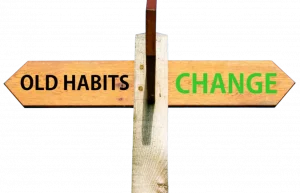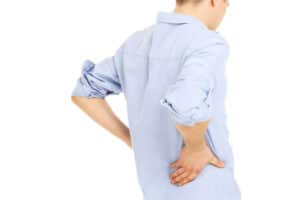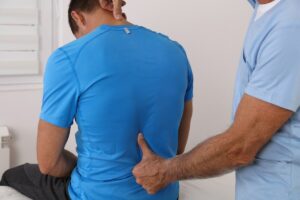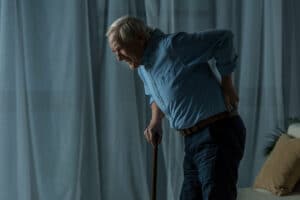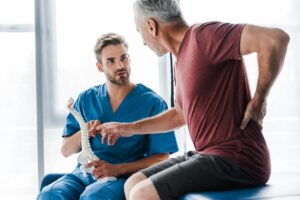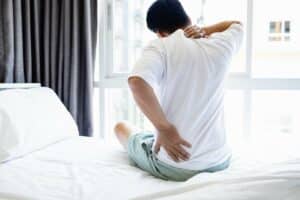Free download: Top 10 Natural & Easy Remedies for Joint Pain from Home. Learn these helpful remedies.
Estimated Reading Time: 11 minutes read
According to the World Health Organization, 60-70% of adults in industrialized countries have low back pain at some point in their lives.
With those numbers, if it’s not happening to you, you probably know someone who is dealing with it.
Unfortunately, it can be difficult to deal with as it often worsens over time and sometimes becomes hard to manage.
The good news is, back mobility exercises may help relieve pressure on your spine and give you some relief!
Table of Contents
What Are the Symptoms of Low Back Pain?
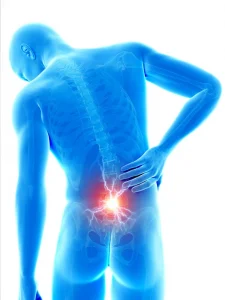
Back pain can be debilitating and affects many people.If you’re one of them, you’re definitely not alone.
Symptoms include localized or widespread aches that can worsen over time.
When you’re in pain, you usually change the way you move. This, in turn, causes more strain on other muscle groups.
In other words, when you hurt, you compensate. And when you do that, it causes more pain.
The most likely causes of back pain are sprains, strains, fractures, arthritis, infections, and core weakness.
Here are some ways you can tell you might have a problem:
- Sitting for prolonged periods of time makes pain worse, but changing positions temporarily reduces this discomfort.
- Pain in the low back that feels dull or achy.
- Pain that travels from back to legs or feet.
- Difficulty standing up straight, walking and going from standing to sitting.
When to See a Doctor?
Sometimes, symptoms can mean something more serious. If you experience the following, seek medical help right away:

- Unbearable pain in the lower back, especially in one spot.
- Increasing numbness in your hands or feet.
- Pressure when urinating or lack of control with urination.
- Fever or chills.
- Serious relapse of low back pain symptoms.
There can also be instances where a person has recovered from the pain before relapsing with increasingly worse symptoms.
In these cases, or if you notice the symptoms above, it’s crucial to be assessed by a doctor. He or she can get you appropriate treatment.
What Type of Low Back Problem Do I Have?
Low back pain can be caused by a variety of different factors and isn’t all the same. Types can include:
1. Acute Lower Back Pain
Ask yourself: How long has my back been hurting? Acute lower back pain involves pain that has been around for less than 12 weeks.
It can be localized or widespread aches and occurs more often in women and older patients.
Have I been injured recently? The reason for acute back pain can be trauma, like a fall, but it can also be unknown.
Listen closely. This is the most important time to address back pain; once it becomes chronic back pain, it’s more challenging to reduce symptoms.
2. Chronic Lower Back Pain
This is when it gets more difficult. Lower back pain that lasts for a longer than a 12 week period of time is chronic and more challenging to treat.
3. Sciatic Lower Back Pain
Sciatica is usually associated with a herniated disc, narrowing of the spine (stenosis), a bone spur, or a tight muscle compressing the sciatic nerve.
It causes intense back and leg pain that can move from the low back to the posterior region of the hips, groin, buttocks and legs.
4. Herniated Disk Lower Back Pain
Herniated disk lower back pain is experienced in the lower spine due to–surprise!–a herniated disc.
These disks sit between your vertebrae, each a jelly-like nucleus surrounded by a fibrous, rubbery layer called the annulus.
A herniated disk occurs when the nucleus moves through a tear in the annulus. The disk can bulge and press on a nerve causing back pain.
What Else Causes Low Back Pain?
As with a lot of things, low back pain is often due to an injury. A fall or sudden movement can really strain the back.
Then again, if you’ve been in that position, you already know that.
However, injury isn’t always the culprit. Sometimes, low back pain can start for no apparent reason at all. Low back pain is also commonly seen in people with fibromyalgia.
Fibromyalgia is a disorder that causes widespread muscle and joint aches throughout the body that lead to severe fatigue and emotional stress.
Gastrointestinal issues, chronic kidney disease, past history of back injury, hypertension or trauma to the back in the past 12 months can all mean you are at higher risk for low back pain.
I know. It’s a long list. And there are many more factors that are unrelated to illness or injury.
Here’s a list of other risk factors that may increase your chance of experiencing low back pain, including some you actually have control over:
Age
Low back pain is more prevalent in people over the age of 65. Degeneration of discs between vertebrae in the spinal cord occurs naturally with aging and may be brought on by normal activities like walking.
For the record, this is not a reason to stop walking. The benefits far outweigh the risk!
In this age bracket, it’s also possible that osteoporosis or brittle bones could also be contributing to low back pain.
Obesity
Pain is common in obese people due to higher levels of stress on the spinal column and spine.
Sometimes this leads to vertebral discs bulging outwards or even rupturing if enough pressure has been put on them.
Maintaining a healthy weight is vital to reducing risk for many different issues. If you don’t already eat healthy and exercise, start now!
Lack of Exercise
Individuals who have a low fitness level are much more likely to experience lower back pain than those who are “in shape”.
Genetics
Of course, genetics also play a role in lower back pain. It can be hereditary, meaning pain may run in the family. And unfortunately, we can choose our genes.
People with certain gene mutations like LBP-1 and SLC6A5 are more likely to suffer with this condition.
This means that it’s possible lower back pain may result from the abnormal physiology of the nerves or muscles that control movement in the spine.
Occupation and Lifestyle
Pain is more common for people who, due to their job or preference, lead a sedentary lifestyle.
If you’re in a desk job, get up and move. Take breaks, use a standing desk, or go for a walk at lunch. Anything helps.
On the flip side, you could also have back pain from repetitive movements at work.
If you’re out there swinging heavy equipment around every day for years on end, there’s a chance it’ll affect your body.
Psychological Conditions
The psychological conditions of an individual can have an effect on lower back pain, too.
Lower back pain is more likely to be found in individuals with chronic fatigue syndrome, depression and anxiety.
This is probably not something to share with your friends with these conditions. No need to create more worry.
Smoking
Smoking is a major risk factor. It causes atherosclerosis, or plaque buildup, in large blood vessels in the body.
This can eventually cut off circulation to the back and spinal cord. Lower back pain is much more prevalent among smokers.
If you’re a smoker, find a reason to quit and find assistance. It’s vital to your longevity.
Diagnosing Low Back Pain
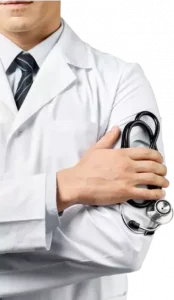
In order to diagnose your pain, a doctor will need to perform a physical exam.
No one likes doctor visits, but in this case, it should be pretty painless.
The doctor will ask questions about your medical history, current issues and any medications that you may be taking.
If you can track the beginning of your pain to a specific event, like an injury or activity, point it out to him or her.
An x-ray or MRI scan is also likely to happen. Remember, if you’re uncomfortable in small spaces, you can find an open or semi-open MRI to do this.
Treatment Options for Low Back Pain
Here’s the part you’ve all been waiting for: treatment options. Back pain treatment options vary depending on the cause and severity of the condition.
Most are focused on relieving symptoms rather than curing the problem completely. Check these out:
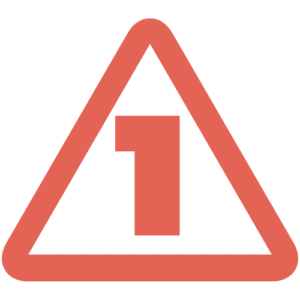
Self Care
Rest
Rest is often the first treatment option. While lower back pain can be caused by sitting or lying down for long periods of time, reducing activity for a day or two can be helpful.
Use this as a chance to get that reading done or catch up on your favorite show.
When you’re feeling better, be sure to take frequent breaks to move around if you have to be seated for long intervals.
Heat/Ice Therapy
Heat therapy is used to treat lower back pain that’s caused by muscle spasms or inflammation. It relaxes the muscles and reduces the spasms and swelling.
Be aware, this option doesn’t address pain caused by internal nerve damage, something that is usually treated with medications, surgery, or physical therapy.
Ice therapy, on the other hand, is used when lower back pain is caused by inflammation or swelling of ligaments in the joints.
It’s useful when pain is associated with joint injuries like sprains, strains and fractures.
Activity Modifications
Activity modification can be part of a prevention strategy, but it can also reduce your symptoms once you’re already experiencing pain.
Sometimes, you just need to stop doing certain things. Or at least be more careful. Maybe this means going from a competitive tennis league to casual weekend games with friends.
Low back pain is often caused by an overuse of the muscles in the region, resulting in strained muscles, spasms, inflammation and general pain.

Medications
While medication can help in the short term, it’s not always advisable because of complications and risks that could cause addiction or dependency. In some severe cases when pain persists, medications may be less effective.
It’s important to have a conversation with your primary care physician if you are interested in going the pill route.
Back Mobility Exercises for Low Back Pain
1. Seated Pelvic Tilts
- Start by sitting in a chair with upright posture with your hands on your hips.
- Curve your pelvis back so that your spine is in the shape of the letter C.
- Then, roll your pelvis forward till you are back in the starting position.
Tip:
Place your hands on your hips to feel your pelvis rolling back and forward. With this exercise, it can be really easy to simply lean back and forward without moving your lumbar spine. Make sure you’re moving your hips!
2. Cat Cow
- Come onto your hands and knees either on the floor or a bed. Shoulders should be directly over the wrists, and your thighs should be perpendicular to the floor.
- Arch your back up while tipping your head down towards your chest like a cat with their back arched.
- Then, allow your back to drop down while lifting your head up like a cow. Think about bringing your belly button towards the floor.
- Repeat. Start with a small range of motion and gradually make the movement bigger, as long as it’s pain free.
3. Book Opener
- Lay on your side with your knees bent and your arms extended in front of you, palms touching.
- Reach up and over to the opposite side with your top hand like a book page opening. You’ll feel your shoulders move, but keep your hips glued to the floor.
- If you can, look at your hand as you move and move so that your cervical spine will rotate along with your thoracic spine.
Lifestyle Changes
People with low back pain may find that it’s less severe when they have a healthy lifestyle. Consider trying the following:
- Taking frequent breaks from sitting or lying down.
- Resting your muscles by stretching them.
- Using ice therapy, heat therapy, and medication for more severe cases of lower back pain.
- Exercising! It’s a natural way to relieve the stress on the back and tendons that cause lower back pain.
- Improving your sleeping habits. Stomach sleepers can experience significant discomfort, while people who cross their legs when they sleep are more likely to suffer from persistent low-back issues.
- Improving your posture.
- Maintaining a healthy weight.
With a few adjustments, many of your low back pain woes should recede. For those with serious cases, make an appointment with your doctor.
There are many ways to address the situation if you can’t prevent it. Those with a white coat can help make pain a thing of the past.


